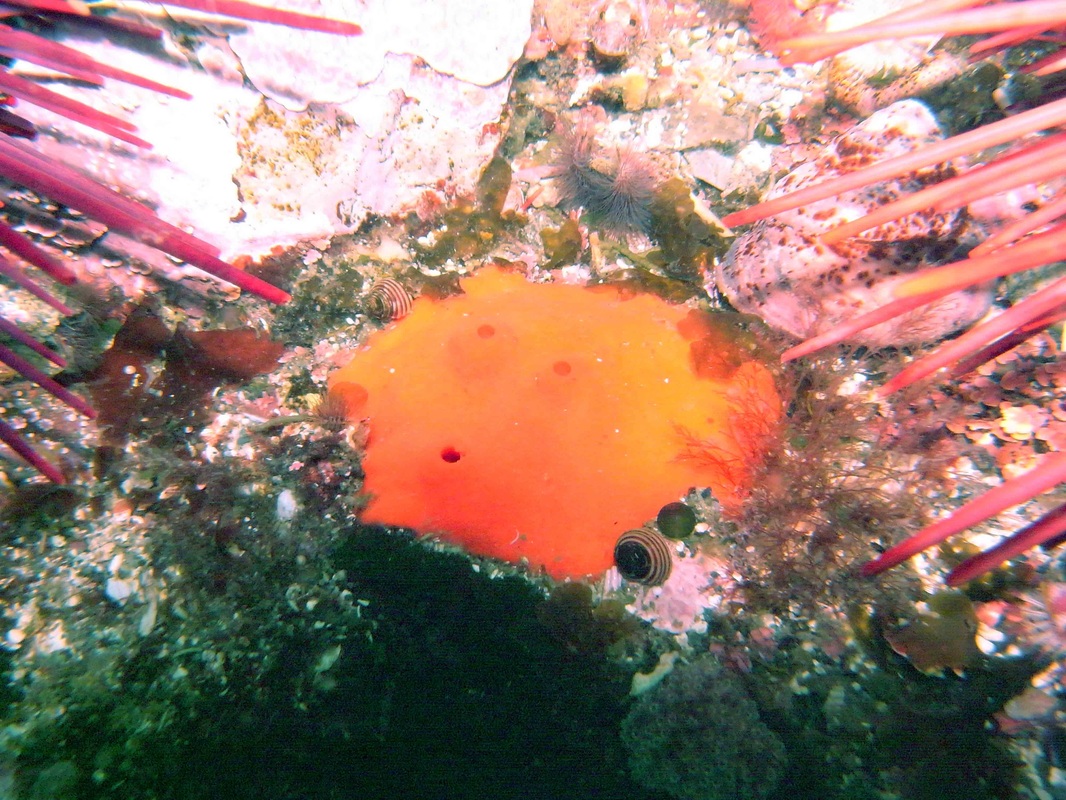Red volcano sponge, thick encrusting scarlet sponge • Acarnus erithacus
Identification
This vibrant encrusting sponge forms a thick (3-5 cm) bumpy layer on rock. Oscula occur on raised projections, making the surface of the sponge appear to be dotted with small volcanoes—and providing it with a nicely descriptive common name.This species varies in both size and shape. Click here for more photos of this species.
Habitat & Range
The red volcano sponge grows on mostly low-lying, horizontal rock surfaces from the intertidal to 700 m depth. Its range extends from southeastern Alaska to Baja California, Mexico.
Similar Species
Other bright red encrusting sponges include Antho karykina, Antho lambei, and Clathria spp. such as the velvety red sponge (Clathria pennata); these species lack the raised oscula of the red volcano sponge.
Intriguing Info
The red volcano sponge is one of a number of red encrusting sponges preyed upon by the red sponge nudibranch (Rostanga pulchra).
This vibrant encrusting sponge forms a thick (3-5 cm) bumpy layer on rock. Oscula occur on raised projections, making the surface of the sponge appear to be dotted with small volcanoes—and providing it with a nicely descriptive common name.This species varies in both size and shape. Click here for more photos of this species.
Habitat & Range
The red volcano sponge grows on mostly low-lying, horizontal rock surfaces from the intertidal to 700 m depth. Its range extends from southeastern Alaska to Baja California, Mexico.
Similar Species
Other bright red encrusting sponges include Antho karykina, Antho lambei, and Clathria spp. such as the velvety red sponge (Clathria pennata); these species lack the raised oscula of the red volcano sponge.
Intriguing Info
The red volcano sponge is one of a number of red encrusting sponges preyed upon by the red sponge nudibranch (Rostanga pulchra).
References
Lamb, A., and Hanby, B. (2005). Marine Life of the Pacific Northwest [electronic version]. Madeira Park, BC: Harbour Publishing.
McDonald, G. Rostanga pulchra MacFarland, 1905. Intertidal invertebrates of the Monterey Bay Area, California. Long Island Marine Laboratory, University of California, Santa Cruz. Accessed 19/11/2015.
Watanabe, J.M. Phylum Porifera: Subtidal Sponges. SeaNet: Common Marine Organisms of Monterey Bay, California. Accessed 19/11/2015.
Authors and editors of page
Kelly Fretwell (2015).
Lamb, A., and Hanby, B. (2005). Marine Life of the Pacific Northwest [electronic version]. Madeira Park, BC: Harbour Publishing.
McDonald, G. Rostanga pulchra MacFarland, 1905. Intertidal invertebrates of the Monterey Bay Area, California. Long Island Marine Laboratory, University of California, Santa Cruz. Accessed 19/11/2015.
Watanabe, J.M. Phylum Porifera: Subtidal Sponges. SeaNet: Common Marine Organisms of Monterey Bay, California. Accessed 19/11/2015.
Authors and editors of page
Kelly Fretwell (2015).




